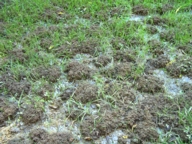|
 Advice on spring lawn work Advice on spring lawn work
By John
Fulton
 Send a link to a friend
Send a link to a friend
[March 09, 2012]
With the early spring warm-up, there
are several complaints about small "hills or mounds" in lawns this
spring -- well, we're almost to spring! In most cases, these are
caused by earthworms or night crawlers. Unless there is a hole along
with the mound. In that case, you may have skunks digging grubs or
worms.
|
|
It is actually
beneficial to have these problems, but sometimes you may not
believe it. The worms aerate the lawn, feed on dead material
that accumulates at the surface and then deposit the digested
material for fertilizer. If it is so bad you can't walk on the
lawn, about the only product that adversely affects earthworms
is Sevin (chlorpyrifos). Granules give you a wider window to get
rain on an application.
The roughness can be helped by rolling the lawn when it is
wet.
Spring lawn care
Spring seeding should be done between March 15 and April 1
for the best chance of success. The reasons for the early date
are the heat and the long germination time for Kentucky
bluegrass. It can take up to a month for bluegrass seed to
germinate. This means an April 1 seeding might germinate May 1.
Then add six to eight weeks for it to become established. This
could then be close to July 1. Usually we tend to get hot
weather about then. Waiting a few years for those fall seedings
to take root will probably increase the number of those trying
again this spring.
Let's start with the basics. The normal seeding is a blend of
Kentucky bluegrass and fine fescue (red or chewings, and not the
tall fescue). Some blends also include a perennial ryegrass with
the other two species. The fine fescue is much better in shade,
and the perennial ryegrass will provide quicker cover.
The seeding rate is generally 4 pounds per 1,000 square feet
in bare dirt. Use 2 pounds per 1,000 square feet in overseeding
thin lawns. Of course, this can run into some real money when
doing very large areas. Many rural seedings are done more on the
basis of a pound per 1,000 square feet. An acre is almost 44,000
square feet, so you can do the math on this one.
Fertilizer is always an area of many questions. The place to
begin is a soil test. This will tell you where you are starting
from. Basic soil test levels for phosphorus, potassium and soil
pH should be in the neighborhood of 40, 350 and 6.1,
respectively. Phosphorus and potassium are on a pound-per-acre
basis. This must be considered if you use labs that report in
parts per million, which will give numbers half as large. These
numbers will provide a great environment for grass. Grass will
grow in very poor conditions, but the lawn certainly won't have
that "manicured" look many strive for.
[to top of second column] |

Lacking a soil test, or being at recommended fertility levels,
general maintenance applications provide a pound each of nitrogen,
phosphorus and potassium per 1,000 square feet of lawn area in May
and again in September. Really lush lawns will usually have twice as
much nitrogen applied in a season, but split among four
applications. Watering is often needed during the summer
applications.
Fertilizer prices remain high.
If you decide to try seeding this spring, remember a couple of
things related to weedkillers.
First, you can't use crabgrass preventer in the same season as
you put down seed. The crabgrass preventer doesn't know the
difference between grass seed and weed seeds.
The second rule is to mow the new seeding at least three times
before trying any broadleaf weedkiller. Generally this means spring
broadleaf control doesn't happen when you seed in the spring. If you
seed in the spring, you control weeds in the fall. Seed in the fall,
and you control weeds and crabgrass in the spring.
If you do plan to use a crabgrass preventer, time it so it is on
about when the forsythia blooms. This would be the approximate soil
and air temperature needed for the crabgrass to germinate. April 1
is a good guess, but the date can vary widely with the weather. Many
crabgrass preventers last only four to eight weeks, so plan on
repeating the application in June anyway.
[By
JOHN FULTON,
University of Illinois Extension] |